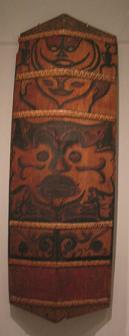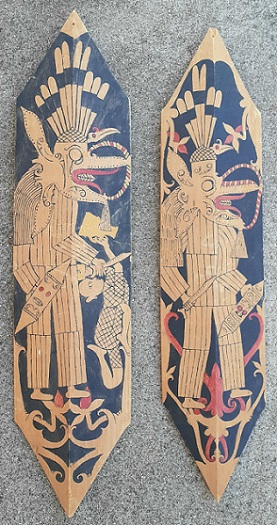Subject: panjamon warrior
Culture: Land Dayak
Setting: tribal warfare, Kalimantan 19-20thc
Object: klau, kliau shield
Dallas Museum of Art > Pacific Islands *
"Shield Indonesia: Kalimantan, Kenyah people Collected in 1897 Wood, paint, and rattan ...
High-ranking Kenyah warriors carried decorated shields during warfare and headhunting raids.
Faces on shields were intended to intimidate or even harm the enemy while protecting the bearer.
Although the identity of these images is not certain, they are often thought to represent ancestors.
Shields of this type have not functioned as defensive objects for many years,
but they have remained essential elements for the ceremonies that accompany all rites of passage."
* Metropolitan Museum of Art > Oceania
"Shield (Klau or Kliau) Kenyah/Kayan people, Kalimantan, Borneo, Indonesia, late 19th-early 20th century Wood, paint, human hair, rattan ...
Warfare formerly played a central role in the art and culture of the Kenyah and Kayan peoples of Borneo. In addition to hereditary rank, prowess in warfare and success in taking enemy heads were the primary means for a man to achieve social prominence. Among the most striking Kenyah/Kayan works were large wood shields (klau or kliau) carried by warriors, which were used in hand-to-hand combat and also at longer range, to parry spears or absorb the impact of darts shot from a blowgun.
Mabee-Gerrer Museum of Art > Weapons and Warriors: The Art of Armaments *
"Dyack Warrior Shield from Borneo
wood" ...
*
* American Museum of Natural History > Mead Hall of Pacific Peoples
* Primitif Stuff Gallery
*





